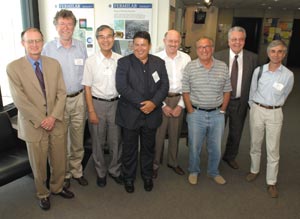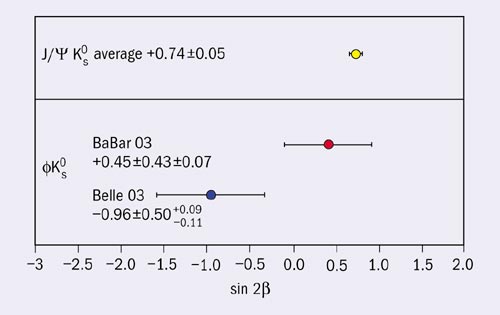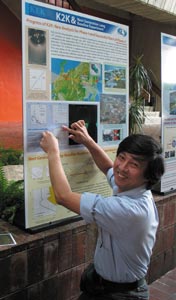The Lepton Photon 2003 conference, hosted by Fermilab, provided an opportunity to take stock and to look ahead to TeV-scale physics in the coming decade. John Womersley and James Gillies report.

The big international summer conferences provide the venue for high-energy physicists to show their newest results in front of a large, influential audience. While delegates always hope for something new and exciting, the pace of research doesn’t always oblige. This year, 650 physicists attended the XXI International Symposium on Lepton and Photon Interactions at High Energies (Lepton Photon 2003) at Fermilab. While radical revisions to our view of the universe are probably not required, interesting new results were presented, and a series of excellent review talks covered the broad sweep of particle physics.
As one might expect for a conference at Fermilab, the first day was devoted largely to collider physics and electroweak-scale phenomena. The experimental state of play with results from LEP, the Tevatron and HERA was covered by a series of speakers: Patrizia Azzi of Padova on top physics, Terry Wyatt of Manchester on electroweak, Michael Schmitt of Northwestern and Emmanuelle Perez of Saclay on Higgs/SUSY and other searches, respectively, and Bob Hirosky of Virginia on QCD. The overall picture remains one of consistency with the Standard Model, but the good news is that with roughly 200 pb-1 of data now recorded at CDF and DØ, the Tevatron’s Run II has entered previously unexplored territory. The experiments are opening up new areas of parameter space and potential discovery reach for new physics, both with their direct searches and through precise measurements of the properties of the top quark and the W and Z bosons. On the theory front, CERN’s Paolo Gambino talked about the status of electroweak measurements and global fits, including the muon (g-2) measurement and NuTeV’s anomalous value of sin2θW, and this led to a spirited discussion in the question and answer session after the talk. Gian Giudice, also from CERN, described theoretical predictions for new physics at colliders, and Thomas Gehrmann of Zurich covered developments in QCD. Cornell University’s Peter Lepage described recent notable progress in lattice QCD calculations, and the last two speakers, Augusto Ceccucci of CERN and Yuval Grossman of Technion, described rare K and B decays. There are recent results from experiments at Fermilab, CERN and Brookhaven, and new initiatives that will significantly extend our sensitivity to new TeV-scale physics through such windows are underway or planned. A reception and poster session wound up the day, with music by the Chicago Hot Six, led by trombonist Roy Rubinstein – otherwise known as Fermilab’s assistant director.
The second day was devoted to heavy-flavour physics and the CKM matrix. Probably the most talked about new result of the conference was presented by Tom Browder of Hawaii, who reported on Belle’s determination of sin 2Φ1 (sin 2ß) from B→ΦKS decays. In the Standard Model, this should be the same as the value extracted from the familiar B→J/ΨKS process, namely 0.74 ±0.05. In 2002, both BaBar and Belle had found negative values, but the errors were large. With more data, Belle reported a new value at the meeting of -0.96 ±0.50 (+0.09/-0.11). By itself this measurement is 3.5σ from the Standard Model, but the situation was confused by a new measurement from BaBar of the same quantity, which has moved much closer to the Standard Model and is +0.45 ±0.43 ±0.07. This puzzle will take either more data or more study before it is resolved.

The Fermilab organizers introduced a number of innovations to the 2003 edition of the conference, one of which was designed to attract the media. Shortly after the new Belle and BaBar results were reported, the first of a series of informal media briefings brought physicists and journalists together over a sandwich lunch to discuss the physics of the previous session.
Hassan Jawahery of Maryland described progress from the B-factories towards constraining the other two angles of the unitarity triangle, and Kevin Pitts of Illinois outlined the complementary capabilities of hadron colliders, which allow access to the BS and to b-baryons. Dresden’s Klaus Schubert reported on significant progress in determining the magnitudes (as opposed to the phases) of the CKM matrix elements, using results from a broad array of experiments. The CKM matrix appears unitary at the 1.8σ level, but some important inputs are still awaited. Gerhard Buchalla of Munich explored tools to understand the QCD aspects of heavy hadron decays. Liverpool’s John Fry covered measurements of rare hadronic decays, while Mikihiko Nakao of KEK did the same for electroweak and radiative rare decays.
In the session on charm and quarkonium physics, Bruce Yabsley of Virginia Tech discussed the limits on new physics from charm decay, concluding that the results from CLEO-c are eagerly awaited. Tomasz Skwarnicki of Syracuse described a revitalized scene in heavy-quarkonium physics, thanks in part to large data samples at BES-II in Beijing, CLEO-III at Cornell and Fermilab’s E835 experiment. He pointed to solid theoretical progress and to new experimental opportunities at BaBar and Belle, as well as CLEO-c. Jussara de Miranda of the Brazilian Centre for Research in Physics asked the question: “why is charm so charming?”, concluding that it provides a powerful bridge to the parton world.
Rounding off the second day was another innovation, a special open session on the Grid, to which the public was invited. Ian Foster of Argonne and Chicago introduced the concept of Grid computing, and CERN’s Ian Bird described its application to the LHC. Bob Aiken from Cisco, Stephen Perrenod from Sun and David Martin of IBM explained the industry’s perspective, while Dan Reed from the National Center for Supercomputing Applications provided the view from an academic computer centre.

Day three began with a session on astroparticle physics, with Pennsylvania’s Licia Verde reporting the exciting results from the Wilkinson Microwave Anisotropy Probe (WMAP). The detailed cosmic microwave background images provided by WMAP bring new insights into the early universe and into the amount of baryonic matter in the universe. Polarization measurements with WMAP also give a handle on the formation of the first stars. The results point to a flat universe consisting of just 4% baryonic matter, with the first stars forming earlier than previously thought at around 200 million years.
Harvard’s Bob Kirshner focused on the universe’s invisible 95%. Supernovae observations indicate an accelerating universe, consisting of about a third matter and two-thirds dark energy. Concluding that there is a bright future for dark energy, he looked forward to a resolution of the questions surrounding the cosmological constant through forthcoming supernovae studies.
Esteban Roulet of Bariloche gave an update on very-high-energy cosmic rays, whose spectrum is described by a “knee” at around 1015 eV and an “ankle” at 1019 eV. Recent work has shown that the chemical composition becomes heavier above the knee, and that above the ankle the extragalactic component dominates. Roulet also raised the question of doing astronomy with ultra-high-energy cosmic rays, saying that although it would be like trying to do optical astronomy with a telescope at the bottom of a swimming pool, the field has promise.
Lyon’s Maryvonne de Jesus gave a comprehensive overview of the status of dark-matter experiments. So far, only the DAMA experiment at Italy’s Gran Sasso underground laboratory has reported a positive signal for WIMPS. A new detector, DAMA/LIBRA, is expected to report its first result towards the end of 2003. A range of experiments planned or in preparation in Europe and the US can exclude much, but not all of the area allowed by the DAMA measurement. Giorgio Gratta of Stanford discussed tritium and double beta decay experiments. The tritium experiments study the endpoint of the decay spectrum from tritium decays to helium, an electron and a neutrino, which is sensitive to neutrino mass. Results from spectrometer-based experiments at Mainz (< 2.2 eV) and Troitsk (< 2.05 eV) are the most sensitive so far. In the future, KATRIN at Karlsruhe should achieve a sensitivity of around 0.25 eV.

In his review of accelerator neutrino experiments, Koichiro Nishikawa of Kyoto focused on the controversial LSND result, which suggests an oscillation scenario incompatible with the accepted picture. Final results from CERN’s NOMAD experiment do not entirely exclude the LSND region, and attention has now passed to MiniBOONE at Fermilab, which has so far recorded some 125,000 events. The first results are expected this autumn. Further ahead are the long-baseline projects NUMI/MINOS at Fermilab-Soudan, and the ICARUS and OPERA detectors, which will observe a neutrino beam from CERN at the Gran Sasso laboratory in Italy.
Reactor-neutrino experiments were covered by Kunio Inoue of Tohoku, who pointed out that all modern experiments are extrapolations of the 1956 Reines and Cowan original, but with vast improvements in scale and flux, along with a better understanding of reactor neutrinos. The fact that Japan’s Kamioka mine has 70 GW of reactor power at distances of 130-240 km and an existing cavern, led to the KamLAND experiment, whose first results provide evidence for neutrino disappearance from a reactor source. Reactor experiments also probe θ13, the last remaining mixing angle in the neutrino sector. The current best measurement of θ13 less than 10 degrees comes from the French CHOOZ experiment. Turning to solar neutrinos, Carleton’s Alain Bellerive gave a comprehensive historical overview from Homestake to Sudbury, but kept the audience waiting for new results from SNO.
In his wide-ranging theoretical review, Alexei Smirnov pointed out that the Lepton Photon conference devoted a full day and a half to discussion of the unitarity triangle for quarks, but no time to the equivalent for leptons. To redress the balance he constructed a leptonic unitarity triangle, which he used to discuss the possibility of measuring CP violation in the leptonic sector. He also pointed out that the only chance of reconciling LSND’s oscillation result with other experiments is by invoking extra, sterile, neutrinos. Deborah Harris of Fermilab then took the podium to give a detailed analysis of the beamline strategies and detector options for facilities ranging from the near-term, such as the Japanese J-PARC to Kamioka beam, to long-term projects such as the neutrino factory.
Day four was devoted to hadron structure and detector research and development. It began with a review of structure functions from deep-inelastic scattering at HERA given by Paul Newman of Birmingham. HERA shut down in 2000 for an upgrade that was designed to boost the luminosity five fold. Now running again as HERA-II, a few tens of inverse picobarns of data are expected this year, and this is sufficient to begin studies of polarization dependence. The theoretical perspective was given by Robert Thorne of Cambridge, who discussed the parton distributions that are essential for analyses at high-energy hadron colliders such as Fermilab’s Tevatron and CERN’s LHC. Toki-Aki Shibata of the Tokyo Institute of Technology discussed measurements with polarized hadrons, both in deep-inelastic scattering and proton_proton collisions, as a probe of the spin structure of hadrons and a tool to develop QCD. After the break, Yuji Yamazaki of KEK continued the QCD theme in his discussion of diffractive processes and vector meson production. Diffractive processes have historically been described in terms of pseudo-particle exchange within Regge theory. Today they can be described at least in part by perturbative QCD, though there remains work to be done.

In his review of heavy-ion collisions, David Hardtke of Berkeley asked the question: “have we seen the quark-gluon plasma at RHIC?” He concluded that although the density and the temperature produced in RHIC gold-gold collisions is at or above the predicted phase transition, no direct evidence has been seen for excess entropy production.
Ties Behnke of DESY and SLAC had the honour of presenting the only detector R&D talk of the conference, and he focused on detectors for a future linear electron-positron collider, for which the requirements are rather different from those for hadron machines.
The final day’s programme looked forward. Veronique Boisvert of CERN reported on a meeting held during the conference by the Young Particle Physicists’ organization, and complimented the conference organizers on the visible role that young physicists had played at Lepton Photon 2003. CERN’s director-general, Luciano Maiani, reported on the status of the LHC and the steps that have been taken over the past couple of years to firm up its financial situation. Dipole magnet production remains the main item that is setting the pace, and first beam is still foreseen for 2007. Vera Luth of SLAC reported on IUPAP’s Commission on Particles and Fields, the umbrella under which the Lepton Photon and ICHEP conferences are held. She observed that the current difficulties experienced by scientists trying to obtain visas to enter the US were of great concern and had a negative impact on the attendance at the conference.
Looking further ahead, Francois Richard of Orsay described the physics motivation for a TeV-scale linear collider, including the constraints that can now be placed on SUSY models from WMAP’s cosmic microwave background measurements, assuming that cosmic dark matter actually consists of neutralinos. SLAC’s Jonathan Dorfan reported for ICFA, and Maury Tigner of Cornell for the International Linear Collider Steering Committee. An international report on the desired parameters of a linear collider is expected this autumn, and this will be followed by the setting up of a committee of “wise persons” from the Americas, Asia and Europe to make a technology recommendation by the end of 2004. In parallel, a task force will recommend how to set up an internationally federated “pre-global design group” intended to evolve into a design group for the accelerator as the project gains approval. Inter-governmental contacts have started with a pre-meeting that was held in London in June.
Ed Witten of Princeton’s Institute for Advanced Study described supersymmetry and other scenarios for new physics. Witten admitted that an anthropic principle could account for the fine tuning and hierarchies that plague the Standard Model, but he hoped that this would not turn out to be the case. The experimenters in the audience enjoyed hearing such a prominent theoretician argue that we need new results that put experiments ahead of theory again – “as is customary in science”. The closing talk, an outlook for the next 20 years, was given by Hitoshi Murayama of Berkeley. He argued that there is a convergence, at the TeV scale, of questions to do with flavours and generations (neutrino masses and mixings, CP violation, B physics), questions to do with unification and hierarchies of forces, and questions to do with the cosmos (dark matter and dark energy). The TeV scale offers the answers to many of these questions, but also forms a cloud that blocks our vision. The next decade holds the exciting promise of dispersing this cloud and giving us the first clear view of what lies ahead.
Further reading
All the presentations are available from the conference website at http://conferences.fnal.gov/lp2003.








